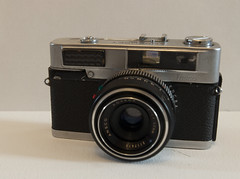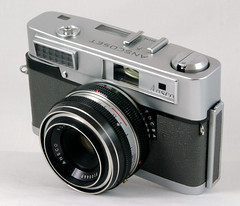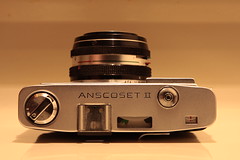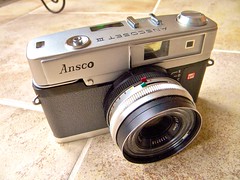Difference between revisions of "Minolta Uniomat"
Hanskerensky (talk | contribs) m (→Links: Refined Link URL) |
(→Links: added to Butkus links for additional models he has) |
||
| (7 intermediate revisions by 4 users not shown) | |||
| Line 27: | Line 27: | ||
{{br}} | {{br}} | ||
| − | In 1960 [[Minolta|Chiyoda]] (after 1962, Minolta) launched its '''Uniomat''' series of [[rangefinder camera]]s with coupled match-needle [[selenium meter]]. Minolta only | + | In 1960 [[Minolta|Chiyoda]] (after 1962, Minolta) launched its '''Uniomat''' series of [[rangefinder camera]]s with coupled match-needle [[selenium meter]]. This camera joined the many other early "automatic exposure" cameras with built-in exposure meters that were released to the market in the 1959/1960 period. |
| + | |||
| + | Minolta's approach to automatic exposure permitted only certain shutter/aperture combinations, an early sort of "programmed" exposure. This fixed combination of shutter speeds and aperture values also permitted a very unusual characteristic of the Citizen shutter: there is no separate aperture diaphragm in this camera. The shutter leaves are used for both the shutter as well as for aperture control. At shutter speeds of 1/100 second and slower, the shutter opens fully as normal and the shutter speed varies according to the exposure value selected (which is automatically set by adjusting the match-needle metering). At these lower shutter speeds the full f/2.8 aperture is always used. At shutter speeds above 1/100 second, the shutter leaves open only partially, with an opening size that varies according to exposure values. In this manner the effective shutter speed and the matching aperture are both controlled by the variable shutter leaf opening. The smaller the opening, the faster the effective shutter speed and the higher the aperture value. This clever design also allows for a very unusual top shutter speed of 1/1000 second, a very high shutter speed for a leaf shutter. | ||
Three different models were marketed from 1960 to 1965, however all are simply labeled '''Uniomat''' on the top panel. They are distinguished as follows : | Three different models were marketed from 1960 to 1965, however all are simply labeled '''Uniomat''' on the top panel. They are distinguished as follows : | ||
| Line 36: | Line 38: | ||
All three models were also sold in the United States by [[Ansco]] as the '''Anscoset''' series, with versions II and III engraved as such on the top plate. The Uniomat II and III overlapped with the successful [[Minolta Hi-Matic]] and [[Minolta Hi-Matic 7| Hi-Matic 7]]—similar models which added autoexposure. | All three models were also sold in the United States by [[Ansco]] as the '''Anscoset''' series, with versions II and III engraved as such on the top plate. The Uniomat II and III overlapped with the successful [[Minolta Hi-Matic]] and [[Minolta Hi-Matic 7| Hi-Matic 7]]—similar models which added autoexposure. | ||
| − | + | ==Specifications== | |
| − | |||
*Type: [[rangefinder camera]] | *Type: [[rangefinder camera]] | ||
*Manufacturer: [[Minolta|Chiyoda Kogaku]] | *Manufacturer: [[Minolta|Chiyoda Kogaku]] | ||
| Line 43: | Line 44: | ||
*Film: [[35mm]] with [[film speed|speeds]] 6 to 1600 [[ASA]] | *Film: [[35mm]] with [[film speed|speeds]] 6 to 1600 [[ASA]] | ||
*Lens: [[Rokkor]] 1:2.8/45mm, 4 elements | *Lens: [[Rokkor]] 1:2.8/45mm, 4 elements | ||
| − | *Shutter: [[leaf shutter]] with speeds from 1/8 sec. to 1/1000 sec., X and M [[flash sync]]hronization, | + | *Shutter: Citizen Optiper Uni [[leaf shutter]] with speeds from 1/8 sec. to 1/1000 sec. plus Bulb, X and M [[flash sync]]hronization, self timer; leaf shutter also functions as aperture control |
| − | *Meter: coupled [[selenium meter]], instrument's match-needle window on top, | + | *Meter: coupled [[selenium meter]], instrument's match-needle window on top, sets a combination of aperture and speed. EV values are also printed on the lens barrel and can be used to set the camera directly. |
*Viewfinder: bright frame finder with superimposed [[coupled rangefinder]] | *Viewfinder: bright frame finder with superimposed [[coupled rangefinder]] | ||
*Film advance: [[film advance|advance lever]] in camera back | *Film advance: [[film advance|advance lever]] in camera back | ||
| Line 79: | Line 80: | ||
}} | }} | ||
{{br}} | {{br}} | ||
| − | |||
| − | |||
| − | |||
| − | |||
| − | |||
| − | |||
| − | |||
| − | |||
{{Flickr_image | {{Flickr_image | ||
|image_source= http://www.flickr.com/photos/michaelbartosek/3870702616/in/pool-camerawiki | |image_source= http://www.flickr.com/photos/michaelbartosek/3870702616/in/pool-camerawiki | ||
| Line 107: | Line 100: | ||
== Links == | == Links == | ||
In English: | In English: | ||
| + | *[https://www.butkus.org/chinon/minolta/minolta_uniomat/minolta_uniomat.htm Minolta Uniomat] and [https://www.butkus.org/chinon/minolta/minolta_uniomat_iii/minolta_uniomat_iii.htm Minolta Uniomat III] user manuals at [https://www.butkus.org/chinon/ Butkus.org] | ||
| + | *[https://www.butkus.org/chinon/ansco/ansco_anscoset/ansco_anscoset.htm Ansco Anscoset] and [https://www.cameramanuals.org/agfa_ansco/ansco_anscoset_ii.pdf Anscoset II] user manuals at [https://www.butkus.org/chinon/ Butkus.org] | ||
* [http://www.cjs-classic-cameras.co.uk/minolta/minolta.html#uniomat Minolta Uniomat cameras] on [http://www.cjs-classic-cameras.co.uk/ CJ's Classic Cameras] | * [http://www.cjs-classic-cameras.co.uk/minolta/minolta.html#uniomat Minolta Uniomat cameras] on [http://www.cjs-classic-cameras.co.uk/ CJ's Classic Cameras] | ||
| Line 115: | Line 110: | ||
[[Category:Japanese 35mm rangefinder]] | [[Category:Japanese 35mm rangefinder]] | ||
| − | [[Category:U|Uniomat]] | + | [[Category:U|Uniomat Minolta]] |
[[Category:Minolta|Uniomat]] | [[Category:Minolta|Uniomat]] | ||
| + | [[Category:1960]] | ||
Latest revision as of 15:32, 22 December 2022

|
| Original Uniomat image by rockershot (Image rights) |

|
| Uniomat II image by Mikel Adell (Image rights) |

|
| Uniomat III image by Cees-Jan De Hoog (Image rights) |
In 1960 Chiyoda (after 1962, Minolta) launched its Uniomat series of rangefinder cameras with coupled match-needle selenium meter. This camera joined the many other early "automatic exposure" cameras with built-in exposure meters that were released to the market in the 1959/1960 period.
Minolta's approach to automatic exposure permitted only certain shutter/aperture combinations, an early sort of "programmed" exposure. This fixed combination of shutter speeds and aperture values also permitted a very unusual characteristic of the Citizen shutter: there is no separate aperture diaphragm in this camera. The shutter leaves are used for both the shutter as well as for aperture control. At shutter speeds of 1/100 second and slower, the shutter opens fully as normal and the shutter speed varies according to the exposure value selected (which is automatically set by adjusting the match-needle metering). At these lower shutter speeds the full f/2.8 aperture is always used. At shutter speeds above 1/100 second, the shutter leaves open only partially, with an opening size that varies according to exposure values. In this manner the effective shutter speed and the matching aperture are both controlled by the variable shutter leaf opening. The smaller the opening, the faster the effective shutter speed and the higher the aperture value. This clever design also allows for a very unusual top shutter speed of 1/1000 second, a very high shutter speed for a leaf shutter.
Three different models were marketed from 1960 to 1965, however all are simply labeled Uniomat on the top panel. They are distinguished as follows :
- Uniomat I with black trim around the selenium meter cell, and dark plastic around the viewer and rangefinder windows on front (1960-1961)
- Uniomat II with chrome trim around the meter cell, and white plastic around the viewer and rangefinder windows on front (1961-1963). Perhaps the most common version.
- Uniomat III with circular selenium meter within the lens filter ring (1963-1965)
All three models were also sold in the United States by Ansco as the Anscoset series, with versions II and III engraved as such on the top plate. The Uniomat II and III overlapped with the successful Minolta Hi-Matic and Hi-Matic 7—similar models which added autoexposure.
Specifications
- Type: rangefinder camera
- Manufacturer: Chiyoda Kogaku
- Year of launch: 1960
- Film: 35mm with speeds 6 to 1600 ASA
- Lens: Rokkor 1:2.8/45mm, 4 elements
- Shutter: Citizen Optiper Uni leaf shutter with speeds from 1/8 sec. to 1/1000 sec. plus Bulb, X and M flash synchronization, self timer; leaf shutter also functions as aperture control
- Meter: coupled selenium meter, instrument's match-needle window on top, sets a combination of aperture and speed. EV values are also printed on the lens barrel and can be used to set the camera directly.
- Viewfinder: bright frame finder with superimposed coupled rangefinder
- Film advance: advance lever in camera back
- Dimensions: 137×80×73mm
- Weight: 710 g
Ansco versions
Also see GAF Ansco Autoset CdS, a 1964 model with no direct Minolta equivalent.

|
| Anscoset I (original model) image by Father of Terror (Image rights) |

|
| Original Anscoset top view image by vincentnip (Image rights) |

|
| Restyled Anscoset, like II image by KKinOK (Image rights) |

|
| Top plate of Anscoset II image by Michael Bartosek (Image rights) |

|
| Anscoset III; meter surrounds lens image by Jim Keeling (Image rights) |
Links
In English:
- Minolta Uniomat and Minolta Uniomat III user manuals at Butkus.org
- Ansco Anscoset and Anscoset II user manuals at Butkus.org
- Minolta Uniomat cameras on CJ's Classic Cameras
In French:
- Uniomat on www.collection-appareils.fr by Sylvain Halgand
In German: